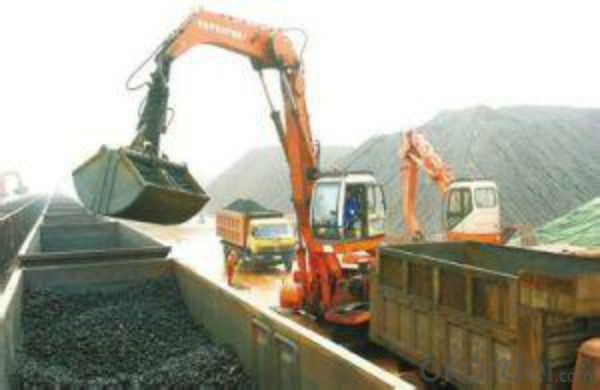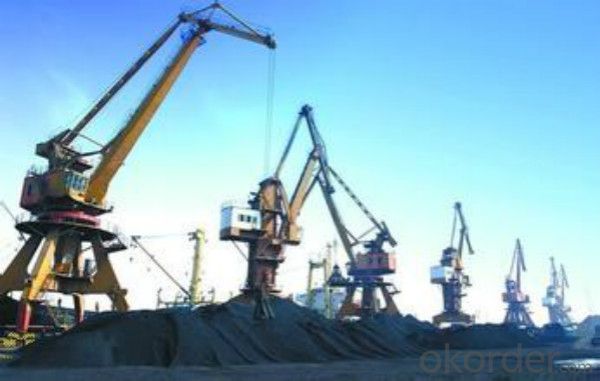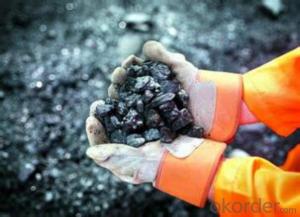30-80mm Low Ash 12.5%Met Coke in High Quality
- Loading Port:
- Tianjin
- Payment Terms:
- TT OR LC
- Min Order Qty:
- 800 m.t.
- Supply Capability:
- 20000 m.t./month
OKorder Service Pledge
OKorder Financial Service
You Might Also Like
Product Description
Met Coke(metallurgical coke) is a carbon material resulting from the manufactured purification of multifarious blends of bituminous coal. In its natural form, bituminous coal is soft; The majority of the unstable components are either reclaimed or recycled.
Features
It is widely used in casting and metallurgy Smelting every tons Irons need about 0.4 to 0.6ton coke. As the reducing agent in the steel-making and foundry industry.
Specification
Item No. | Ash (%) max | S (%) max | F.C. (%) min | V.M (%) max | Moisture (%) max | P (%) max | CSR (%) min | CRI (%) max | Cal.Value (≥Kcal/Kg) |
NF-M001 | 9 | 0.6 | 89.5 | 1.2 | 5 | 0.035 | 65 | 25 | 7250 |
NF-M002 | 10.5 | 0.6 | 88 | 1.2 | 5 | 0.035 | 65 | 25 | 7100 |
NF-M003 | 12 | 0.6 | 86.5 | 1.5 | 5 | 0.035 | 63 | 28 | 6900 |
NF-M004 | 13 | 0.6 | 85.5 | 1.5 | 5 | 0.035 | 60 | 30 | 6800 |
Pictures


FAQ
1 What is the packing?
Packaging Details: | 1. jumbo ton bag |
2 Delivery time? Delivery Detail: |
15 days after we get the advanced payment or original L/C |
- Q:How can individuals reduce their carbon footprint?
- There are several actions individuals can take to reduce their carbon footprint and contribute to a more sustainable future. Here are some effective ways to achieve this: 1. Reduce energy consumption: Conserving energy is crucial in reducing carbon emissions. Switch to energy-efficient appliances, turn off lights when not in use, unplug electronics when not in use, and use natural lighting whenever possible. Additionally, adjusting thermostats to energy-saving temperatures and using programmable thermostats can significantly reduce energy consumption. 2. Use renewable energy sources: Transitioning to renewable energy sources, such as solar or wind power, can greatly reduce carbon emissions. Install solar panels on rooftops, or consider purchasing green energy from utility companies that offer renewable options. 3. Reduce water usage: Conserving water indirectly helps reduce energy consumption and carbon emissions. Fix leaky faucets, take shorter showers, install water-saving fixtures, and collect rainwater for outdoor use. Also, consider using drought-resistant landscaping to reduce water usage for gardening. 4. Consume consciously: Make sustainable choices when purchasing products. Opt for durable and long-lasting items, repair and reuse instead of replacing, and prioritize products made from recycled or sustainable materials. Additionally, support local and sustainable businesses that prioritize eco-friendly practices. 5. Minimize transportation emissions: Reduce reliance on private vehicles by opting for public transportation, carpooling, biking, or walking whenever possible. If owning a car is necessary, choose electric or hybrid vehicles. Regular maintenance, proper tire inflation, and avoiding unnecessary idling all contribute to reducing transportation emissions. 6. Adopt a plant-based diet: The food industry has a significant carbon footprint, especially due to livestock production. Reducing meat consumption or adopting a plant-based diet can greatly reduce carbon emissions and also offer health benefits. If going completely plant-based is not feasible, try incorporating more vegetarian or vegan meals into your diet. 7. Reduce waste generation: Waste contributes to greenhouse gas emissions, so reducing waste is essential. Opt for products with minimal packaging, recycle diligently, compost organic waste, and avoid single-use plastics. Reduce food waste by planning meals, buying only what is needed, and properly storing leftovers. 8. Support environmental initiatives and organizations: Engage with local and global organizations working towards environmental conservation. Participate in community clean-ups, support reforestation efforts, and advocate for sustainable practices in your workplace and community. By implementing these strategies in our daily lives, individuals can make a significant impact in reducing their carbon footprint and help combat climate change. It is important to remember that every small action matters, and collectively, we can create a sustainable future for generations to come.
- Q:What are the impacts of carbon emissions on the stability of mountain glaciers?
- Mountain glaciers are significantly affected by carbon emissions, which have significant consequences for their stability. The release of carbon dioxide and other greenhouse gases into the atmosphere contributes to global warming and climate change. This rise in global temperatures directly impacts the health and stability of mountain glaciers. One of the main outcomes of increased carbon emissions is the accelerated melting of mountain glaciers. Warmer temperatures cause glaciers to melt at a faster pace, resulting in a decrease in their size and volume. This not only affects the visual appeal of these natural wonders but also has major implications for water resources and ecosystems. Mountain glaciers serve as natural reservoirs, holding water in the form of ice and gradually releasing it over time. This process helps regulate water flow in rivers and streams, ensuring a consistent water supply for downstream communities, agriculture, and ecosystems. However, as carbon emissions contribute to glacier melting, this natural water storage mechanism is disrupted. The loss of glaciers leads to reduced water availability during dry seasons and can result in water scarcity for communities dependent on glacier meltwater. Moreover, the retreat of mountain glaciers due to carbon emissions has ecological consequences. These glaciers provide critical habitats for various plant and animal species. The loss of glacier ice and associated ecosystems can have a ripple effect on the entire ecosystem, resulting in the decline or even extinction of species reliant on glacier-fed environments. The impacts of carbon emissions on mountain glaciers also extend beyond local communities and ecosystems. Glacial meltwater plays a significant role in the overall water supply in many regions globally. As glaciers shrink and vanish, the availability of water resources becomes uncertain, particularly in areas heavily reliant on glacier meltwater. This can potentially lead to conflicts over water resources and worsen existing tensions. In conclusion, the stability of mountain glaciers is severely affected by carbon emissions. The accelerated melting of glaciers disrupts water availability, threatens ecosystems, and presents challenges for water resource management. It is crucial to reduce carbon emissions to mitigate these impacts and preserve the integrity and functionality of mountain glaciers.
- Q:Helmet material: ABS composites, FRP, carbon fiber, what are the differences? How to tell good from bad?
- ABS resin is one of the five major synthetic resin, impact resistance, heat resistance, low temperature resistance, chemical resistance and excellent electrical properties, but also has the characteristics of easy processing, product size stability, good surface gloss, easy coloring, painting, but also the surface plating metal, electroplating, welding, hot pressing and bonding the two processing, widely used in the industrial field of mechanical and automotive electrical and electronic instruments, textiles and construction, is a very widely used thermoplastic engineering plastics.Materials (Composite) is a material consisting of two or more than two different materials which, in physical or chemical ways, macroscopically form new properties. Various materials in the performance complement each other, and produce synergistic effect, so that the comprehensive performance of composite material is better than the original material, and meet a variety of different requirements. The matrix materials of composite materials are divided into two major categories: metal and nonmetal. Metal matrix commonly used aluminum, magnesium, copper, titanium and its alloys. The non-metallic matrix mainly includes synthetic resin, rubber, ceramic, graphite, carbon and so on.
- Q:What are the impacts of carbon emissions on the stability of coral reefs?
- Carbon emissions have significant impacts on the stability of coral reefs. Increased carbon dioxide levels in the atmosphere lead to ocean acidification, which hinders coral reef growth and weakens their structural integrity. Additionally, rising sea temperatures due to carbon emissions result in coral bleaching, where corals expel the symbiotic algae they depend on for survival. These combined effects make coral reefs more susceptible to disease outbreaks, slow recovery from disturbances, and ultimately increases the risk of their collapse, posing a significant threat to marine biodiversity and coastal communities that rely on them.
- Q:What is carbon footprint labeling?
- Carbon footprint labeling is a system that provides information about the carbon emissions associated with a product or service. It aims to educate consumers about the environmental impact of their purchases and enable them to make more sustainable choices. The labeling typically includes a measure of the greenhouse gas emissions produced during the entire life cycle of a product, including its production, transportation, and disposal. This allows consumers to compare the carbon footprints of different products and make informed decisions based on their environmental values. Carbon footprint labeling is an important tool in promoting sustainability and encouraging businesses to reduce their emissions. It also raises awareness about the impact of individual consumption choices on climate change and encourages a shift towards more environmentally friendly alternatives.
- Q:How does carbon impact the prevalence of avalanches?
- The prevalence of avalanches is greatly influenced by carbon. The rise in carbon emissions and subsequent global warming results in alterations to the stability of snowpack, ultimately impacting the frequency and severity of avalanches. As temperatures increase, snowfall patterns become more uncertain, characterized by more frequent freeze-thaw cycles. This causes the snowpack to weaken, as the snow loses its cohesion and becomes more prone to sliding. Moreover, higher temperatures lead to a greater amount of rainfall instead of snow, further destabilizing the snowpack by adding weight and reducing its strength. These changes in snowpack stability heighten the probability of avalanches occurring. Additionally, climate change also modifies the timing and duration of snow accumulation. Warmer temperatures result in earlier snow melt, which can result in a diminished snowpack during the peak avalanche season. This, in turn, increases the likelihood of triggering avalanches as there is a smaller amount of stable snow to support the added weight and stress from additional snowfall or human activity. Furthermore, carbon-induced climate change has the ability to affect the frequency and intensity of extreme weather events, such as heavy snowfalls or rainstorms. These events can cause rapid and significant alterations to snowpack conditions, ultimately leading to an elevated risk of avalanches. In conclusion, the impact of carbon on the prevalence of avalanches is substantial. The warming climate affects snowpack stability, the timing and duration of snow accumulation, and the frequency of extreme weather events, all of which contribute to an increased risk and prevalence of avalanches.
- Q:What do you mean by carbon fiber for 1K, 3K, 6K and 12K?
- This is the specification of carbon fiber, refers to the number of filaments in carbon fiber tow, 1K=1000 (root), 3K=3000 (root), 6K=6000 (root), 12K=12000 (root). At the same time, 1K, 3K, 6K, and 12K are also called small tow.The relationship between the properties of carbon fibers and the number of filaments is described below:According to the number of carbon fiber bundle of carbon fiber filaments can be divided into small tow and tow two. Compared with small tow, the disadvantage of large tow is that when the structure of the plate is made, the tow should not spread out, resulting in the increase of the monolayer thickness, which is not conducive to the structural design. In addition, large tow carbon fiber adhesion, wire breaking phenomenon more, which makes the strength and stiffness of the affected, a decrease in performance, the performance of dispersion will be larger. Aircraft, spacecraft generally only a small tow carbon fiber, so the small tow carbon fiber is also known as the "space" of carbon fiber, large tow carbon fiber is known as the "industrial grade carbon fiber.But large tow production costs than small tow low, and with the progress of the production technology, people familiar with the structure of the carbon fiber material, large tow carbon fiber more and more stringent requirements for reliability field. In this way, between the small and large tow tow distinguish changes, such as earlier in the number of single tow 12000 (12K) as the dividing line, but the number of carbon fiber 1K~24K is divided into small bundles, rather than 48K designated as large tow. While the Airbus Company has begun to use 24K carbon fibers in the manufacture of A380 super large aircraft, it is estimated that as the technology advances, the line between the small tow and the big tow will push up.
- Q:How does carbon dioxide affect climate change?
- Climate change is significantly influenced by carbon dioxide (CO2), a greenhouse gas. CO2 is released into the atmosphere through natural processes like volcanic eruptions or human activities such as burning fossil fuels. Its presence in the atmosphere traps heat from the sun, preventing it from escaping back into space. This phenomenon is known as the greenhouse effect. Human activities, particularly the burning of fossil fuels like coal, oil, and natural gas, have led to an imbalance in the natural carbon cycle. This has caused an increase in CO2 concentration in the atmosphere, resulting in a rapid rise in global CO2 levels. Consequently, the Earth's surface is warming, and climate patterns are changing. Since the Industrial Revolution, the burning of fossil fuels has significantly elevated atmospheric CO2 levels, leading to an increase in the Earth's average temperature. This temperature rise impacts various aspects of the climate system, causing a range of effects. One of the most visible outcomes of increased CO2 levels is global warming. This warming leads to the melting of glaciers and polar ice, which in turn raises sea levels. Rising sea levels pose a threat to coastal areas and low-lying islands, causing increased flooding, coastal erosion, and potential displacement of communities. Moreover, elevated CO2 levels contribute to more frequent and intense heatwaves, droughts, and wildfires in many regions. These extreme weather events negatively affect agriculture, water availability, and human health. Carbon dioxide also disrupts ecosystems by altering the growth patterns and distribution of plant and animal species. Changes in temperature and precipitation patterns, driven by increased CO2 levels, disturb the delicate balance of life, leading to biodiversity loss and potential species extinction. To mitigate the impacts of CO2 on climate change, it is crucial to reduce greenhouse gas emissions. Transitioning to renewable energy sources, improving energy efficiency, and adopting sustainable practices are important steps in reducing CO2 emissions and limiting the extent of climate change. Additionally, efforts to restore and protect forests and other natural carbon sinks can help absorb and store CO2, thus mitigating its effects on the climate.
- Q:Is carbon a solid, liquid, or gas at room temperature?
- Carbon is a solid at room temperature.
- Q:What are the economic impacts of carbon emissions?
- The economic impacts of carbon emissions are significant and wide-ranging. Carbon emissions, primarily from the burning of fossil fuels, contribute to climate change and global warming. These changes in the climate have a direct impact on various economic sectors and can lead to both short-term and long-term economic consequences. One of the most notable economic impacts of carbon emissions is the cost of dealing with the effects of climate change. Extreme weather events, such as hurricanes, floods, and droughts, become more frequent and intense as a result of carbon emissions. These events can cause extensive damage to infrastructure, homes, and businesses, leading to significant economic losses. For example, in 2017, the United States experienced a record-breaking hurricane season, with hurricanes Harvey, Irma, and Maria causing an estimated $265 billion in damages. Moreover, carbon emissions also affect agricultural productivity. Climate change alters temperature and precipitation patterns, which can disrupt crop production and decrease yields. This, in turn, affects food prices and availability, impacting both consumers and farmers. Additionally, carbon emissions contribute to the acidification of oceans, which can harm marine ecosystems and disrupt fisheries, leading to economic losses for fishing communities. Furthermore, carbon emissions have implications for public health, which can result in economic burdens. Air pollution caused by carbon emissions can lead to respiratory and cardiovascular illnesses, increasing healthcare costs and reducing workforce productivity. In addition, extreme heatwaves, exacerbated by carbon emissions, can have a detrimental impact on worker productivity and labor capacity, affecting economic output. To mitigate the economic impacts of carbon emissions, many countries have implemented policies and regulations to reduce greenhouse gas emissions. These policies often include carbon pricing mechanisms, such as carbon taxes or cap-and-trade systems, which aim to incentivize the transition to cleaner energy sources and reduce carbon emissions. While these policies may have short-term economic costs, they can also create opportunities for innovation and the development of green technologies, which can lead to long-term economic benefits. In conclusion, the economic impacts of carbon emissions are significant and multifaceted. From the costs of dealing with climate-related disasters to the effects on agriculture, public health, and productivity, carbon emissions have far-reaching consequences. Addressing these impacts through the implementation of effective climate policies is crucial to mitigate the economic risks and foster a sustainable and resilient economy.
1. Manufacturer Overview |
|
|---|---|
| Location | |
| Year Established | |
| Annual Output Value | |
| Main Markets | |
| Company Certifications | |
2. Manufacturer Certificates |
|
|---|---|
| a) Certification Name | |
| Range | |
| Reference | |
| Validity Period | |
3. Manufacturer Capability |
|
|---|---|
| a)Trade Capacity | |
| Nearest Port | |
| Export Percentage | |
| No.of Employees in Trade Department | |
| Language Spoken: | |
| b)Factory Information | |
| Factory Size: | |
| No. of Production Lines | |
| Contract Manufacturing | |
| Product Price Range | |
Send your message to us
30-80mm Low Ash 12.5%Met Coke in High Quality
- Loading Port:
- Tianjin
- Payment Terms:
- TT OR LC
- Min Order Qty:
- 800 m.t.
- Supply Capability:
- 20000 m.t./month
OKorder Service Pledge
OKorder Financial Service
Similar products
New products
Hot products




























